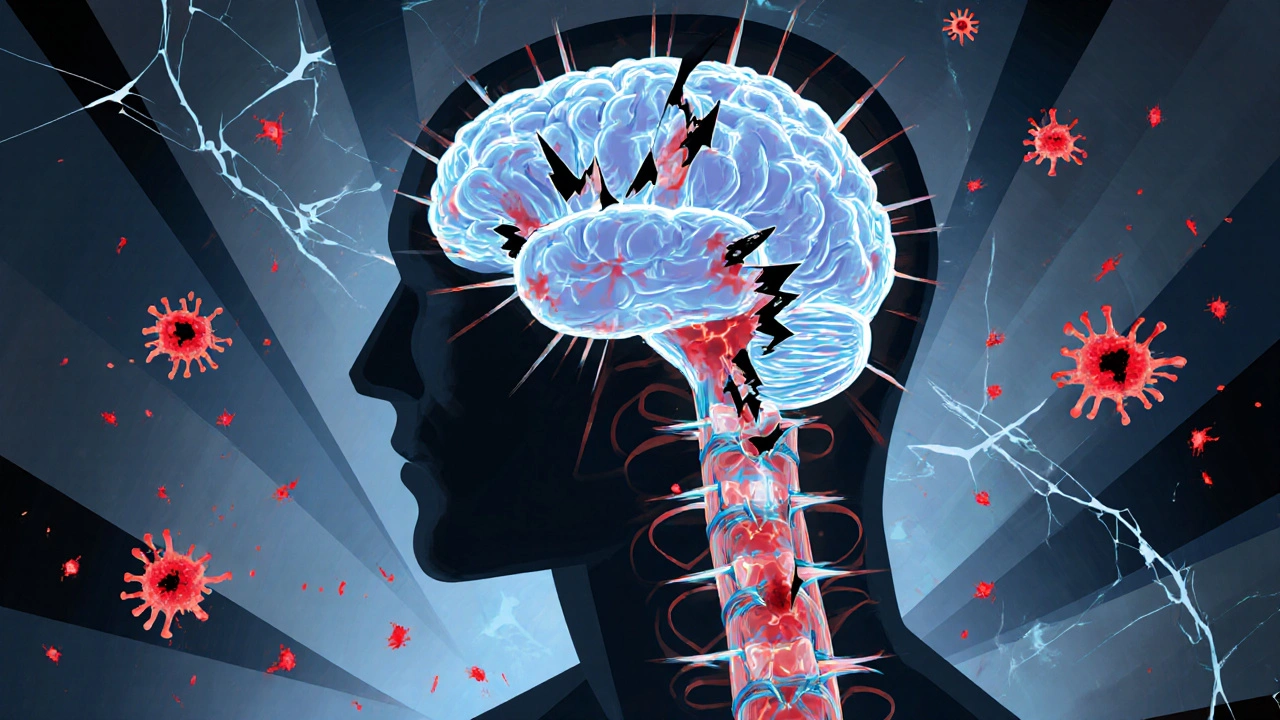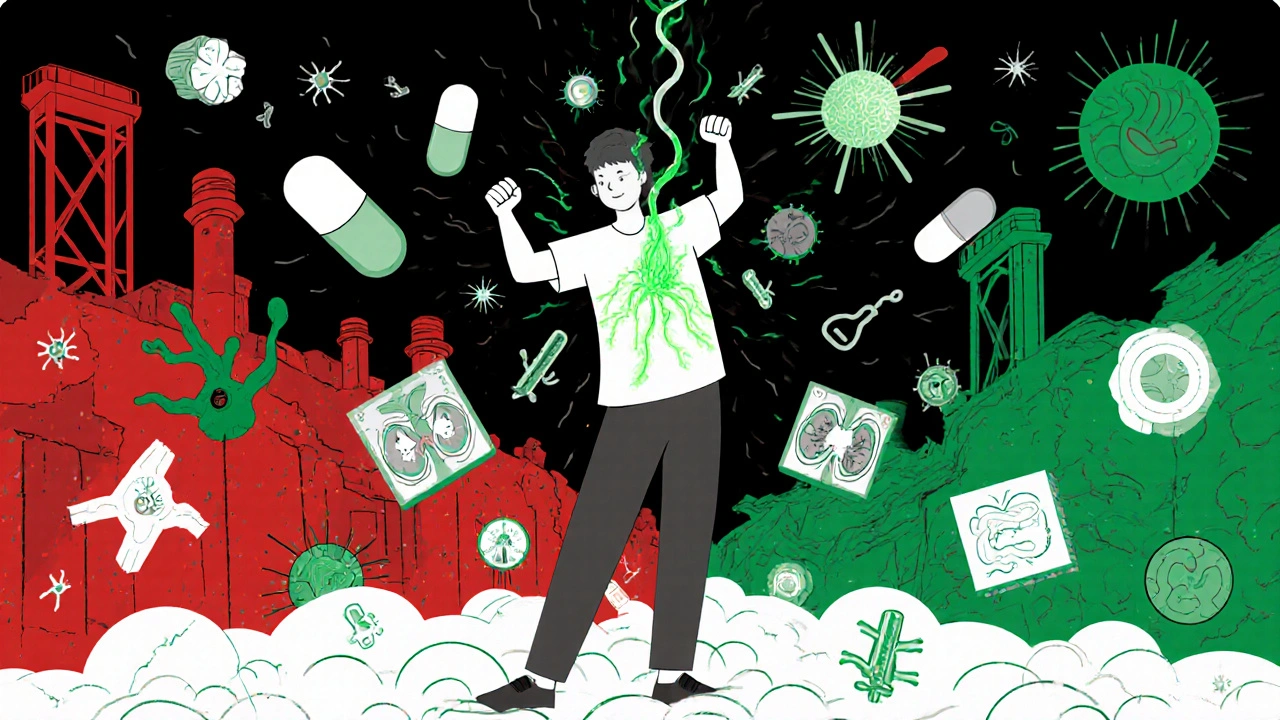SEARCH
Multiple Sclerosis: What It Is, How It Works, and What You Can Do


Multiple sclerosis is not just a neurological condition-it’s an autoimmune attack on the very system that lets your body move, think, and feel. Your immune system, designed to protect you, turns against your own nervous system, stripping away the protective coating around nerve fibers. This isn’t a slow decline you can ignore. It’s a constant battle happening inside your brain and spinal cord, often starting when you’re in your 20s or 30s. And while there’s no cure yet, we know more now than ever about how to slow it down, manage symptoms, and live well.
What Actually Happens in Your Body With MS?
Imagine your nerves as electrical wires. They need insulation to send signals quickly and clearly. That insulation is called myelin, made by cells called oligodendrocytes. In multiple sclerosis, your immune system sends T-cells and antibodies across the blood-brain barrier and starts chewing up that myelin. It’s like stripping the plastic off a power cord-now the signal sputters, skips, or dies completely.
This damage shows up as scars, or plaques, on MRI scans. These aren’t just random spots-they’re in specific areas: the brain’s white matter, optic nerves, spinal cord. When lesions form in the optic nerve, you might get blurred vision. If they hit the spinal cord, you could lose balance or feel numbness in your legs. The damage doesn’t heal perfectly. Each attack leaves behind a little more scarring, and over time, those scars add up.
Without myelin, nerve signals slow down by 30-50%. That’s why simple tasks-like lifting a cup or finding the right word-can suddenly feel impossible during a flare-up. It’s not weakness. It’s a broken signal.
The Four Types of MS-And Why It Matters
Not everyone with MS follows the same path. There are four main types, and knowing which one you have changes everything about your treatment and outlook.
- Clinically Isolated Syndrome (CIS): This is your first episode-maybe sudden vision loss, leg weakness, or tingling that lasts more than 24 hours. If an MRI shows lesions typical of MS, you have a 60-80% chance of developing full MS within 10 years.
- Relapsing-Remitting MS (RRMS): This is the most common form-85% of cases. You get attacks (relapses) that last days or weeks, then things get better, sometimes completely. But even when you feel fine, damage is still quietly building.
- Secondary Progressive MS (SPMS): After 10-25 years, about half of RRMS patients start to decline steadily, even without clear relapses. This isn’t a sudden switch-it’s a slow creep. Walking gets harder. Fatigue gets worse. Memory slips.
- Primary Progressive MS (PPMS): This affects 15% of people from day one. No relapses. No remissions. Just a steady worsening. It’s harder to treat because inflammation is less obvious, but new drugs are finally showing promise.
Doctors use the Expanded Disability Status Scale (EDSS) to track progress. A score of 0 means no disability. A score of 6 means you need a cane to walk. In PPMS, people often climb 1-1.5 points per year on this scale without treatment.
Why Do People Get MS? It’s Not Just Bad Luck
MS doesn’t come out of nowhere. It’s a mix of genes and environment. You don’t inherit MS, but you can inherit a higher risk. The biggest genetic red flag? A version of the HLA-DRB1*15:01 gene. Having it triples your chance of getting MS.
But genes alone don’t cause it. Something else has to trigger it.
One of the strongest links is Epstein-Barr virus-the virus that causes mononucleosis. People who’ve had mono have up to a 32-fold higher risk of MS. That doesn’t mean everyone with mono gets MS. But almost every person with MS has had EBV. It’s like a hidden key that unlocks the disease in people already genetically wired for it.
Vitamin D is another big piece. People living far from the equator-like in Canada, Scotland, or Scandinavia-have much higher rates of MS. Sunlight helps your body make vitamin D. Low levels (under 30 ng/mL) are linked to a 40% higher risk. That’s why doctors in northern climates often test and supplement vitamin D early.
And it’s not just one trigger. It’s a chain: genes + EBV + low vitamin D + smoking + stress. Each one adds pressure. Remove one, and you might delay or even prevent the disease.

What It Feels Like-Beyond the Medical Terms
Doctors talk about lesions and EDSS scores. But patients talk about fatigue so deep it feels like your bones are made of lead. A 2023 survey of 150,000 people with MS found 78% said fatigue was their worst symptom-not pain, not numbness, not weakness. It’s the kind of tired that doesn’t go away after sleep.
Then there’s brain fog. People describe it as trying to speak but the words won’t come. Or walking into a room and forgetting why. Reddit’s r/MS community has thousands of posts about this. One user wrote: “I know the word. It’s right there. But my brain won’t let me say it.” That’s not aging. That’s MS.
Bladder problems, muscle spasms, tingling that feels like ants crawling under your skin-these are common too. And they’re not just physical. The emotional toll is huge. Depression and anxiety affect nearly half of people with MS. It’s not just reacting to the diagnosis. The disease itself can change brain chemistry.
How Is MS Diagnosed? It’s Not Just One Test
You can’t diagnose MS with a blood test. It’s a puzzle. Doctors need proof that damage happened in different places at different times. That’s the McDonald Criteria.
Here’s how it works:
- MRI scan: This is the star of the show. A 3 Tesla MRI finds 30% more lesions than older 1.5 Tesla machines. They look for lesions in at least two of these areas: brain, spinal cord, optic nerves.
- Timing: You need both new lesions (glowing with gadolinium dye) and old ones (dark, scarred). Or, a follow-up scan shows new damage.
- Spinal fluid test: A lumbar puncture checks for specific antibodies linked to MS. Not always needed, but helpful if MRI is unclear.
- Evoked potentials: This test measures how fast your nerves respond to light or sound. Slowed signals = myelin damage.
It often takes 6-12 months and 3-5 specialist visits to confirm MS. That’s because doctors have to rule out everything else-Lyme disease, lupus, vitamin B12 deficiency, even rare tumors.
Treatments Today-What Actually Works
There’s no cure. But there are 20+ FDA-approved drugs that can change the course of MS. They fall into three groups:
- Disease-modifying therapies (DMTs): These reduce relapses and slow damage. Newer ones like ocrelizumab and ofatumumab cut relapses by 50% or more. They’re given as infusions or monthly shots.
- Symptom management: Medications for spasticity (baclofen), fatigue (amantadine), bladder issues (oxybutynin), and depression (SSRIs).
- Rehabilitation: Physical therapy isn’t optional-it’s essential. A 2021 Cochrane Review found balance training reduces falls by 47%. Occupational therapy helps with daily tasks. Speech therapy tackles brain fog and swallowing issues.
Cost is a real barrier. DMTs run $65,000-$87,000 a year. But 90% of U.S. patients get help through manufacturer copay programs. In Canada, most are covered under provincial drug plans.
And not all treatments work the same for everyone. A 2023 survey found 42% of people quit injectable drugs within a year because of side effects-flu-like fevers, injection site burns, nausea. Newer oral and infusion options are easier to stick with.

What’s on the Horizon? Hope Beyond the Drugs
The next wave of MS research isn’t just about suppressing the immune system. It’s about repairing the damage.
Scientists are testing drugs that help remyelinate-grow new myelin. One drug, opicinumab, showed a 15% improvement in nerve signal speed in early trials. Another, ANV419, a selective estrogen receptor beta agonist, cut new brain lesions by 40% in a 2024 Phase II trial.
Stem cell therapy is being tested in 127 active trials. The idea? Reset the immune system by wiping it out with chemo, then rebuilding it with your own stem cells. Early results show some people go years without relapses.
Even gut health is in the spotlight. A 2023 trial using fecal transplants from healthy donors showed a 30% drop in inflammatory markers. The theory? Your gut bacteria talk to your immune system. Change the gut, maybe you calm the attack.
And the liberation procedure? That idea-that clogged neck veins cause MS-was debunked. Ten rigorous trials showed no benefit. Don’t waste time or money on it.
Living With MS-It’s Not Just Medicine
People with MS are living longer, fuller lives than ever before. In Sweden, 70% of those diagnosed after 2010 are still walking without help 20 years later. That’s up from 45% for those diagnosed before 1990. Why? Early treatment.
Work is a big challenge. Eighty-two percent of employed people with MS need accommodations. Flexible hours? 65% ask for it. Remote work? 58%. Most employers don’t know they’re legally required to provide these under the ADA (in the U.S.) or similar laws elsewhere.
Exercise matters. Walking, swimming, yoga-anything that keeps you moving-slows decline. A 2022 study found people who exercised 3+ times a week had 30% less brain volume loss over two years.
And community helps. Online groups like MyMSTeam give people a place to vent, share tips, and feel less alone. You’re not broken. You’re adapting.
What’s the Real Outlook?
MS doesn’t kill you. Most people with MS live a normal lifespan. But it can steal your independence if you don’t act.
The key? Diagnosis early. Start treatment fast. Stay active. Manage stress. Get enough vitamin D. Don’t smoke. Build your support team-neurologist, therapist, physical trainer, friends, family.
This isn’t a death sentence. It’s a life with new rules. And those rules? They’re getting better every year.